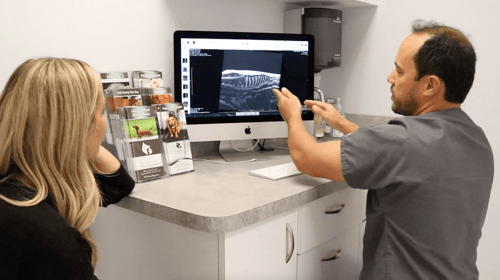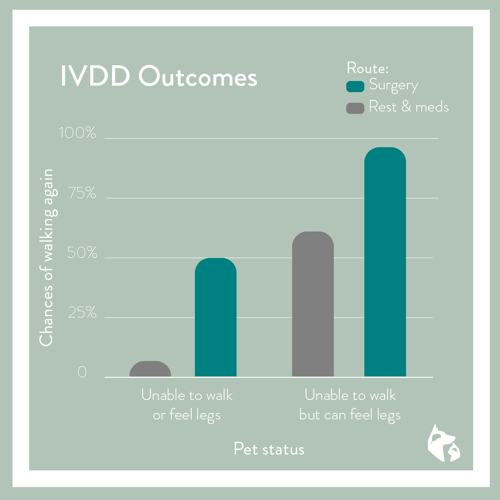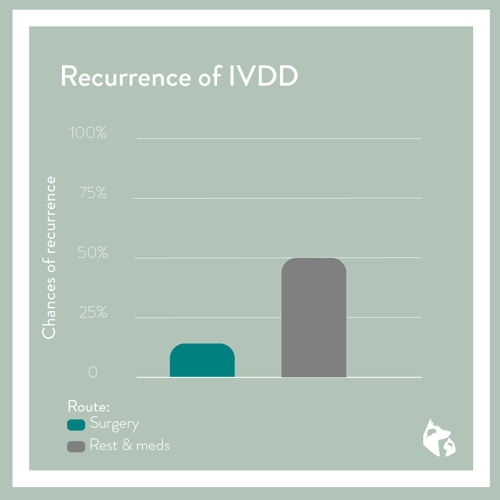5 Things Every French Bulldog Owner Needs To Know About IVDD
I absolutely love French bulldogs. I’m a Pug person at heart, but there’s just something about those ears, those eyes, that face, that I can’t resist in a French bulldog. If you’re reading this, I suspect you feel the same way.
As with any breed, French bulldogs are predisposed to getting certain diseases. For example, many German shepherds are more likely to have hip problems. Cocker spaniels are more likely to get ear infections. Dachshunds are known for developing back problems such as intervertebral disc disease (IVDD).
French bulldogs have grown immensely in popularity over the last few years and are also quickly becoming known for developing intervertebral disc disease. In fact, some weeks I see more French bulldogs than I do dachshunds.
Since IVDD is so common in French bulldogs, it can come on suddenly and can cause permanent inability to use the legs. We’ve put together some facts that every French bulldog parent needs to know about IVDD.
What is Intervertebral Disc Disease (IVDD)?
Just like in people, the neck and back are made up of multiple bones lined up in a row. These bones are called vertebrae. The vertebrae surround and protect the spinal cord, which transmits information from the brain to the legs and from the legs back to the brain.
In between each pair of vertebrae is an intervertebral disc that is shaped like a jelly donut. The disc has an inner jelly part and an outer donut part. Intervertebral discs act as spacers and cushions between the bones of the neck and back.
In certain breeds, including the French bulldog, the jelly inside part of the disc can come out of the donut at high speed. When this happens, it hits the spinal cord, causing bruising and swelling. Additionally, it compresses the spinal cord.
What Are Symptoms of IVDD in French Bulldogs?
Symptoms of IVDD depend on where the disc problem is (neck versus back) and how severe the spinal cord injury is.
Symptoms of a slipped disc in the neck may include (from mildest to more severe):
- Holding the head low, arching the back, crying out, not wanting to lift the head, holding the ears back, panting excessively, and/or spasming of the neck muscles.
- Walking wobbly or drunk in all four legs. Sometimes French bulldogs may drag the toenails or occasionally stumble and fall in the limbs.
- Unable to walk in all four legs.
Symptoms of a slipped disc in the back may include (from mildest to more severe):
- Back pain, tense belly, not wanting to eat, crying when picked up and reluctance to jump.
- Walking wobbly or drunk in the rear limbs. They may scuff the toes or criss-cross the limbs.
- Unable to walk in the rear limbs, dragging of the rear limbs.
How Is French Bulldog IVDD Diagnosed?
While IVDD is the most common cause of spinal injury in dogs, there are other diseases that can look very similar. French bulldogs can develop spinal tumors, meningitis, infections, malformations and others.
Additionally, French bulldogs tend to get worse faster than other breeds and are more likely to develop a life-threatening complication called myelomalacia (explained below). For those reasons, we tend to recommend testing a little more proactively than we do in other breeds.
An experienced neurologist can examine your pet, determine where the problem is, what the severity is, list the most likely cause and recommend the best course of action.
Radiographs (X-rays) alone cannot diagnose IVDD, although it is useful in looking for other causes such as bony tumors, broken bones or bone infections.
Magnetic Resonance Imging (MRI) is the best way to diagnose IVDD. CT scans can sometimes diagnose IVDD but can miss many other causes. Myelography is an older test that is not recommended since it is more invasive and complications can arise.

How Is French Bulldog IVDD Treated?
In general, there are two ways to treat IVDD.
CRATE REST AND MEDICATION
The first treatment option is crate rest and medications (anti-inflammatory medications, pain medications, muscle relaxants, etc). This is appropriate for dogs with mild signs (pain only or mild wobbliness when they walk).
Crate rest involves being confined to a small crate (approximately 3 x 4 feet for the average-sized French bulldog). They can have a bed, food and water and toys as long as they don’t play rough with the toys. Time outside of the crate should be limited to short walks on a leash and harness for 5-10 minutes.
SURGERY
The second treatment option is surgery. This is appropriate for dogs that are more severely affected (difficulty walking, unable to walk), dogs with severe pain, dogs where the symptoms are getting worse despite rest and medications, or dog where the symptoms improve but come back later.
What Is the Likelihood of Successful Treatment for IVDD in French Bulldogs?
Successful treatment is possible for the majority of French bulldogs with IVDD. There are a handful of factors that determine the likelihood of success.
DIAGNOSIS
The first factor is getting a diagnosis. Since many other diseases can look like IVDD, confirming a diagnosis (as opposed to just suspecting based on symptoms and X-rays) is the most important step in success.
SEVERITY OF SYMPTOMS
The second factor is the severity of symptoms. Dogs that have mild symptoms (pain only, walking but wobbly) have a higher success rate than dogs that have more severe symptoms (inability to feel the limbs).
TREATMENT OPTION
The third factor is which treatment option is selected.
TREATMENT SUCCESS RATE
Dogs that are painful, walking wobbly, or even unable to walk but still able to FEEL the limbs have about a 55-60% chance of getting better with crate rest and medications. Those same dogs have about a 95% chance of getting better with surgery.
However, dogs that are unable to FEEL the limbs have only a 5% chance of getting better with rest and medications and only a 50% chance of getting better with surgery.

WHAT DO WE MEAN BY "GET BETTER"?
When I say “better” or “successful outcome” I mean a pain-free, happy dog that is able to walk, run, play, urinate and defecate voluntarily. However, some dogs that are severely affected (unable to move or unable to feel) may still have some residual weakness or incoordination.
WHAT ARE THE ADVANTAGES AND DISADVANTAGES OF SURGERY?
The main disadvantages are the need for anesthesia and the costs associated with MRI and surgery.
The main advantages are knowing the cause as opposed to suspecting, having a higher (95% vs. 60%) chance of success, a faster recovery, a more complete recovery, a lower chance of IVDD happening again, and a lower chance of getting worse.
What Are the Chances of IVDD Happening Again in French Bulldogs?
Unfortunately, dogs that slip one disc are at risk for slipping another one at some point in their life. At Southeast Veterinary Neurology, we perform a preventative procedure on all French bulldogs that elect surgery for their disc herniation. This decreases the likelihood of recurrence from 50% (without surgery) to 10-15% (with surgery).

What Is Myelomalacia?
Myelomalacia is a life-threating complication of IVDD. It occurs in dogs that are unable to move and feel the rear limbs.
In some dogs, when the slipped disc injures the spinal cord, it can cause a chain reaction of progressive damage to the spinal cord that creeps down the spinal cord to the tail and up the spinal cord toward the front legs.
As it creeps forward, the front legs become weak and then it becomes difficult for the dog to breathe. These symptoms can happen anywhere within the first week of losing feeling in the rear limbs.
Unfortunately, there isn’t anything that can be done to stop the progression of myelomalacia.
The chance of developing myelomalacia is about 10% for most breeds. French bulldogs are much more likely to develop myelomalacia than other breeds.
Again, this is only for dogs that are unable to move and FEEL their rear limbs, but is a reason to call Southeast Veterinary Neurology at the first sign of IVDD.
Vet Neurological Care for French Bulldog IVDD
We hope you find this information useful. French bulldogs are incredibly popular and are truly part of the family. Since this disease is so common and is so devastating, we want to inform as many people as possible.
We hope you and your French bulldog never need Southeast Veterinary Neurology, but if you do, we are available 24/7/365.
Southeast Veterinary Neurology employs board-certified neurologists and a team of experts that only treat neurological conditions. With locations in Boynton Beach, Jupiter, Miami and Virginia Beach we are always here for you.